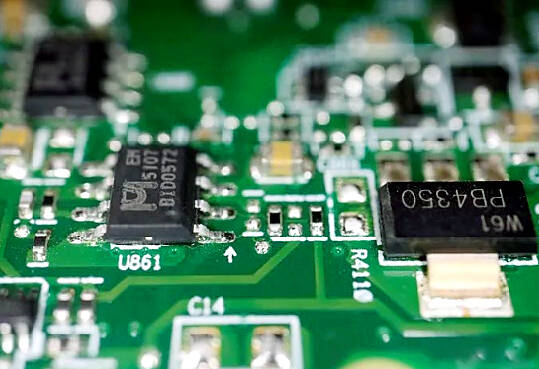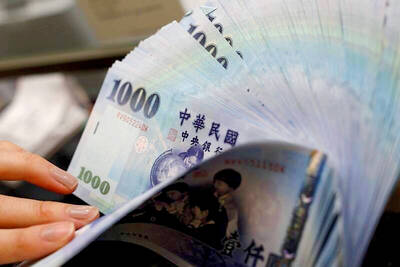South Korea has asked Washington to review its criteria for new semiconductor subsidies, concerned over the impact of rules to limit chip investment in countries such as China, a US public filing showed.
In March, the US Department of Commerce proposed rules to prevent China and other countries it deems to be of concern from tapping funds of US$52 billion earmarked for semiconductor manufacturing and research under the Creating Helpful Incentives to Produce Semiconductors (CHIPS) and Science Act.
A leading chipmaker and major investor in the US chip sector, South Korea asked the US to review the rule that prevents recipients of US funding from building new facilities in such countries, beyond 5 percent of existing capacity.

Photo: Reuters
“The Republic of Korea believes ‘guardrail provisions’ should not be implemented in a manner that imposes an unreasonable burden on companies investing in the United States,” South Korea said, using its official name.
The filing gave no further details, but the South’s Yonhap news agency said Seoul had asked to raise the limit to 10 percent.
The South Korean Ministry of Trade, Industry and Energy declined to comment.
Washington has said the incentives aim to help restore the US’ leadership in semiconductor manufacturing, boost employment, and ensure economic and national security.
South Korea’s Samsung Electronics Co and SK Hynix Inc, the world’s top two makers of memory chips, have invested billions of dollars in chip factories in China.
Samsung is building a chip plant in Texas that could cost more than US$25 billion.
In its comments, Samsung sought clarification of the proposed rule to ensure that investments in the US chipmaking sector were “not unduly and unintentionally restricted,” a filing showed.
SK Hynix also made comments, but the public version gave no details.
Its parent, SK Group, which plans to invest US$15 billion in the US chip sector, some for an advanced chip packaging factory, has said it is considering applying for funding.
“Potential CHIPS Act funding recipients have numerous existing legacy facilities in China,” an industry group, the Semiconductor Industry Association, said.
“It is critical for these companies to be able to protect their past investments in these facilities by ensuring they remain commercially viable,” it said.
SK Hynix and Samsung Electronics did not immediately provide comments to Reuters.
The United Auto Workers union has said funding applicants should be ruled ineligible if they did not agree to allow union organizing.
“The US government should not be in the business of funding union-busting employers,” it said in a filing on Tuesday.
The commerce department began accepting subsidy applications for leading-edge chip facilities in March. On June 26, it is to open applications for “current-generation, mature-node and back-end” production facilities.

Merida Industry Co (美利達) has seen signs of recovery in the US and European markets this year, as customers are gradually depleting their inventories, the bicycle maker told shareholders yesterday. Given robust growth in new orders at its Taiwanese factory, coupled with its subsidiaries’ improving performance, Merida said it remains confident about the bicycle market’s prospects and expects steady growth in its core business this year. CAUTION ON CHINA However, the company must handle the Chinese market with great caution, as sales of road bikes there have declined significantly, affecting its revenue and profitability, Merida said in a statement, adding that it would

MARKET LEADERSHIP: Investors are flocking to Nvidia, drawn by the company’s long-term fundamntals, dominant position in the AI sector, and pricing and margin power Two years after Nvidia Corp made history by becoming the first chipmaker to achieve a US$1 trillion market capitalization, an even more remarkable milestone is within its grasp: becoming the first company to reach US$4 trillion. After the emergence of China’s DeepSeek (深度求索) sent the stock plunging earlier this year and stoked concerns that outlays on artificial intelligence (AI) infrastructure were set to slow, Nvidia shares have rallied back to a record. The company’s biggest customers remain full steam ahead on spending, much of which is flowing to its computing systems. Microsoft Corp, Meta Platforms Inc, Amazon.com Inc and Alphabet Inc are

RISING: Strong exports, and life insurance companies’ efforts to manage currency risks indicates the NT dollar would eventually pass the 29 level, an expert said The New Taiwan dollar yesterday rallied to its strongest in three years amid inflows to the nation’s stock market and broad-based weakness in the US dollar. Exporter sales of the US currency and a repatriation of funds from local asset managers also played a role, said two traders, who asked not to be identified as they were not authorized to speak publicly. State-owned banks were seen buying the greenback yesterday, but only at a moderate scale, the traders said. The local currency gained 0.77 percent, outperforming almost all of its Asian peers, to close at NT$29.165 per US dollar in Taipei trading yesterday. The

The US overtaking China as Taiwan’s top export destination could boost industrial development and wage growth, given the US is a high-income economy, an economist said yesterday. However, Taiwan still needs to diversify its export markets due to the unpredictability of US President Donald Trump’s administration, said Chiou Jiunn-rong (邱俊榮), an economics professor at National Central University. Taiwan’s exports soared to a record US$51.74 billion last month, driven by strong demand for artificial intelligence (AI) products and continued orders, with information and communication technology (ICT) and audio/video products leading all sectors. The US reclaimed its position as Taiwan’s top export market, accounting for